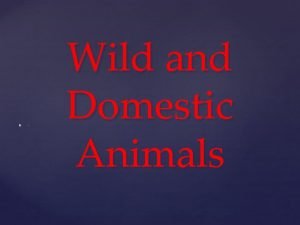Wild life safety Seeing wild animals up close



















- Slides: 19

Wild life safety

Seeing wild animals "up close and personal" can be a great thrill, and as wildlife become more accustomed to the presence of humans, close encounters are becoming more common. But wild animals are very different from domesticated livestock and companion animals. Even wild animals that appear quite tame can be very dangerous. In addition, some wild animals are susceptible to diseases that affect humans and/or domesticated animals. Keep the thrill from turning into tragedy

Lions: Lions are carnivores, If you get to close there is no telling what might happen. They can be aggressive animals and are very territorial. If faced with no protection against a lion the out come would not be good so we ask that you please keep distance. Also please do not feed the animal unless you’re a zoo or wildlife worker for it could be fatal. If you’re a Zoo worker or wildlife handler then you should know not to go directly into the predators territory but to instead use the feeding shoot made for these types of things.

opportunity of swimming or diving with sea lions. Indeed, jumping in the water in front of a sea lion colony with hundreds of them around may seem at first glance a scary and potentially risky thing to do. But in fact, it is the biggest fun imaginable. When swimming with sea lions you will be surrounded in seconds by dozens of sea lion heads popping out of the water, curiously looking at you with their incredibly beautiful big black eyes. “Wait a moment? No more sea lions in front of you? ” Well, just take a look over your shoulder the whole bunch is already behind your back making fun of you. And that’s what it is all about, having a good time – for both, humans and sea lions. As curiously as we are look at them they look at us too. The only thing you have to do is enjoy observing them popping out of the water in front of and around you, jumping and hurling around or looking at you from below and rocketing past you. Swimming with sea lions is great fun for everybody. You don’t need to be a great swimmer either as your wet suit will keep you warm and floating above the waterline and you don’t need to actually swim great distances. The sea lions will approach you, maintain their distance and leave, once they are done checking you out – giving way to a dozen or so other sea lions also wanting to have a look! You came here for a dive? You will get that and much more. However, don’t expect great visibility, when diving in front of a sea lion colony. The water is full of floating/sinking remains from their last dinner (Sorry, but we at Nature Expeditions like to tell it like it is). But you wont need to see very far as the sea lions will approach you very close. While at the surface, they mostly maintain a safe distance of more than an arms length, but under water they often become “a little” bolder: Being marine animals with no hands to actually touch you, sea lions will try to figure you out using their mouth.

Falcons are medium sized birds of prey found all across the world although falcons tend to prefer the more temperate regions of the Northern Hemisphere. Falcons are best known for their ruthlessness and their incredible flying abilities. Falcons have tapered wings that allow the falcon to change direction extremely quickly especially when compared to other birds. Falcons have been recorded diving at speeds of up to 200 mph, meaning they are the fastest creatures on the planet! There are more than 40 different species of falcon that can be found all around the world such as the peregrine falcon and the black falcon. Falcons vary in size from 25 cm tall to more than 60 cm tall, but the height of the falcon depends on the species. The peregrine falcon is the most common bird of prey in the world and is found on every continent besides Antarctica. Falcons are birds of prey and are therefore known for their incredible hunting skills and being a ruthless, dominant predator within their environment. Falcons hunt their prey from the skies above and swoop down through the air to catch it once they have spotted a meal with their incredible eyesight. Falcons hunt all kinds of small animals like mice, frogs, fish and falcons will even catch small birds in the air. Due to the large size, speed and alertness of the falcon, the falcon has few natural predators and even fewer that are actually airborne. Humans and wolves tend to be the main predators of the falcon on the ground and eagles and even large owls have been known to hunt the smaller species of falcon (and of course the young and inexperienced falcons) in the air. The eggs and chicks of the falcon are particularly vulnerable to being eaten. Falcons have adapted in many ways to maximize their chances of survival in the skies.

Orangutans are known to be the giants of the jungle but wild orangutans are becoming rarer and rarer as forest fires and palm plantations have decreased the orangutans natural habitat and led to sever population declines. Scientists believe that there approximately 50, 000 orangutans left in the wild, most of which are found on the Indonesian island of Borneo. Orangutans are only also found on the neighboring island of Sumatra, where they live in nests in the dense tropical jungle. Despite the constant demise of the wild orangutan population, scientists have found a reclusive orangutan habitat in an inaccessible mountainous region deep in the Borneo jungle. There are thought to be up to 2, 000 orangutan individuals coexisting in an area just a few kilometers square.

The chinstrap penguin is a small species of which is found in habiting the rocky land islands of the Antarctic Ocean. The chinstrap penguin name derives from the narrow black band under their heads. Chinstrap penguins are one of the most easily identifiable of all of the penguin species, mainly due to the marking on their chins. Chinstrap penguin are also known to congregate together in their millions on small Antarctic islands. There are believed to be more than 7 million breeding pairs of chinstrap penguins. Chinstrap penguin spend their lives hunting for krill and small fish and crustaceans in the surrounding waters, coming onto land to breed, rest and to escape the large ocean predators. Chinstrap penguin are carnivorous birds, and catch numerous species of fish, crabs, shrimp, squid and krill in their strong beaks. Parents hunt for food in the ocean to take back to their chicks on the land.

Frogs are amphibians, creatures that inhabit both land water environments equally successfully. There are thought to be around 5, 000 different species of frog around the world. Frogs are well known for their coiled, sticky tongue which they project out of their mouths to catch insects. Frogs are also well known for being able to breathe through their skin as well as their lungs. Some frogs can leap over 50 times their body length, which results in the frog jumping an enormous height. Many frogs in cooler climates hibernate through the winter in compost heaps and big piles of mud. Most species of frog have webbed hands and feet, which aids the frog in swimming, jumping and even climbing. Frogs tend to lay their eggs (known as frog spawn) in ponds and lakes but some frogs have been known to also lay their eggs in big puddles. Baby frogs are called tadpoles and are completely water-based until the tadpoles develop arms and legs and are able to climb out of the

The Association of Zoos and Aquariums, which accredits 73 US zoos with elephants, concluded in a study that handlers are at greater risk the more time they spend in unrestricted space with the animals. In a new policy, the association said it would require all zoos to provide barriers by September 2014 so that handlers would not generally be in direct contact with elephants, instead feeding them through bars or other restraints. Zoos will have a grace period until 2016 if they cannot meet the guidelines but are making an effort. The policy still allows for direct contact with elephants if there is an explicit reason, such as medical treatment or breeding. "While this is a policy aimed squarely at occupational safety, it does so in a way that is consistent with providing the highest level of elephant care and welfare, " association president Jim Maddy said in a statement this week.

Polar bears can be found from the permanent pack ice and coasts of the Arctic Ocean and Arctic islands to southern Hudson Bay. They live mainly on sea ice or on land within a few kilometers of the coast. In summer, polar bears often travel along coastlines using points of land rocky islets near the coast to navigate. They also travel inland have been seen as far as 150 kilometers from the coast. Polar Bear Feeding Areas In fall, winter and spring polar bears hunt seals along the sea ice edge, near open water and areas of pushed up sea ice. They also hunt for seals in places where sea ice is thin or cracked, such as at tide cracks in land-fast ice or at toes of glaciers. In spring females with cubs hunt for seal birthing areas along pushed up sea ice, as well as near cracks in land-fast ice, particularly in bays. In summer polar bears are forced ashore when sea ice melts. They feed on birds, eggs, and small mammals along coastlines, beaches and rocky islands near the coast. They also scavenge anything from wildlife carcasses to

Mammal. Zebras are members of the horse family, Equips. They live in family groups of more than a dozen zebras with one stallion as head. While zebras' stripes may look the same to us, each has a unique pattern that can be recognized by other family members. When zebras run as a herd, the stripes help protect them by confusing predators with a dizzying display. Zebras sleep in shifts, so that some members of the herd are always awake and alert. The leader uses sounds to signal when all is safe or when a threat occurs. Even though they weigh from 227 to 272 km (500 to 600 lb), zebras can run 64 km

The kangaroo is an Australian icon. Its size, strength and speed are traits that make it a natural logo or emblem for Australian organizations and sporting clubs. It is also part of our national coat of arms. Kangaroos are also symbolic of another Australian trait: to stick up for yourself and not back down (with their large back feet and tail, kangaroos find it hard to move backwards). However, unlike their human counterparts, adult males fight their rivals to gain higher status within a local group or 'mob' and the dominant male will father the next generation of joeys. But many people see large male kangaroos as placid grazing animals. The reality is that they can be aggressive towards people. Although the risk of this happening is very small, we still need to be wary around them.

The Jaguar is the largest feline on the American continent, and is the only one of the world’s ‘big’ cats to be found in the New World. Jaguars are closely related to Leopards and have a number of similar characteristics including the distinctive spotted pattern on their fur. The Jaguar is the third biggest Cat in the world behind the Tiger and the Lion and is well known for it’s immense power and agility. The name Jaguar comes from the Native American word jaguar — “he who kills with one leap”. Jaguars have been hunted through the ages mainly for their staggeringly beautiful fur. Although hunting for Jaguar fur is now prohibited, population numbers have declined throughout much of their natural range, with Jaguars having completely disappeared from a number of areas

The hippopotamus has the reputation of being the most dangerous wild mammals in Africa. Based on human fatalities, this reputation is probably well deserved. One thing that must be remembered is that unlike most land animals that usually have many escape options, these animals have a relatively small area to escape to in their "water homes". If they get frightened on land they charge back to the safety of water and trample anything that comes in its way. On land a hippopotamus can reach a top speed of 40 kilometers per hour and they are surprisingly agile. To get between this animal and water is to risk being trampled as it tries to get to safety. Yawning displays is a dominance signal and a clear signal for intruders -

I'm a novice at keeping Tarantula's and I personally don't recommend handling any tarantula's, I own 2 Cobalt blue females (The gruesome twosome) who do not hesitate to have a go at me if they are disturbed even taking out dead crickets they will strike at the tweezers, I recently transferred one to a larger tank and to be honest I was sweating they are very quick of the mark, ammo I would say this species should be treated with the utmost caution and respect. . . .

Today there approximately 40 panda reserves across Southwestern China. Some are Nature Reserves providing a safe habitat for wild Giant Pandas, like a National Park Other reserves protect the wild Giant Pandas while having scientific research centers to study their behavior and for breeding captive Giant Pandas. The reserves are intended to protect the Giant Panda's natural habitat. Logging is extremely detrimental to the habitat so in 1998 a logging ban was implemented by the Chinese government to slow the destruction Poaching and illegal logging are still problems in some areas. Although Giant Pandas were once hunted for their pelts, most Giant Pandas that are injured or killed by poachers today are inadvertently harmed when Giant Pandas are caught in traps meant for musk deer, taken, and other animals

Koalas in the wild face a series of threats to their continued survival. A major threat is the continuing urbanization of their habitat and associated threats like cars and dogs. Over 4, 000 koalas are killed each year by dogs and cars alone. In addition, stress caused by the loss of their habitat causes symptoms of diseases like chlamydia. Approximately 80% of original koala habitat has already been destroyed. This has forced koalas to live alongside people in urban areas, and means that property owners have a special responsibility to take the particular needs of koalas into consideration in their lifestyle. Because most koala habitat is on private land, people living in areas with koalas can have a great influence on whether koala populations in their area survive or become extinct. It is their responsibility, along with government at all levels, to assist in preserving this precious resource. Because much of the koala's habitat is zoned residential, or is in farming areas, their future is largely dependent upon the attitude of property owners

Adolescent females transfer to another troop before reproducing at around eight years of age. Generally the first troop a female reproduces in will become her permanent family. A female's status or rank in the family is generally determined by the order in which she was recruited into the troop. Late arrivals do not receive the benefits of high ranking females such as having their offspring remain close to the dominant silverback for protection. It is for this reason that females most often join a lone silverback or a newly formed troop rather than a long-established one. 4. An adolescent male most often splits from his parent group due to lack of breeding opportunity. Usually the adolescent male will remain solitary until he forms his own troop. This process takes several years and begins by the juvenile male separating himself just outside from the troop. As time progresses, his distances increase from the parental group. 5. Troop populations usually range in size from 2 to 12 individuals with 9 being the average. They are highly synchronized in their activity patterns. If a troop consists of multiple silverbacks they are usually the sons of the dominant adult male silverback. One of the largest gorilla troops identified had 4 silverbacks, 5 blackbacks, 12 adult females, and 16 young.

Camels are even-toed ungulates that have one or two humps… the one-humped camel, or dromedary camel, is found in the Arabian deserts of the Middle East and North Africa, while the two-humped camel, or Bactrian camel, is native to the Gobi Desert in China and the Bactrian steppes of Mongolia… another camel lives in Australia… they are feral, or wild, camels… they were dromedary camels that were imported to provide transportation… they have become a pest because they are eating the natural vegetation… the camel is related to the alpaca, llama, guanaco and vicuna… wild Bactrian camel is at extreme risk of becoming extinct.
 Seeing is believing atau believing is seeing
Seeing is believing atau believing is seeing Life is a test quotes islam
Life is a test quotes islam Mrs wild going wild
Mrs wild going wild Wild sweet pea vs wild potato
Wild sweet pea vs wild potato How to tell wild animals pictures
How to tell wild animals pictures Agnes ling
Agnes ling 10 lines on wild animals
10 lines on wild animals Https//a-z-animals.com/animals
Https//a-z-animals.com/animals Consumer producer decomposer
Consumer producer decomposer Parasitic food chain example
Parasitic food chain example Animals that eat both plants and animals
Animals that eat both plants and animals Emily dickinson facts
Emily dickinson facts 4 ways of seeing
4 ways of seeing Plane mirror location
Plane mirror location On seeing the elgin marbles
On seeing the elgin marbles Lindamood bell seeing stars lesson plans
Lindamood bell seeing stars lesson plans If only i could fly asl translation
If only i could fly asl translation Describe the bedroom which montag enters
Describe the bedroom which montag enters Electromagnetic waves seeing objects and color
Electromagnetic waves seeing objects and color Thomas believe by seeing
Thomas believe by seeing





































